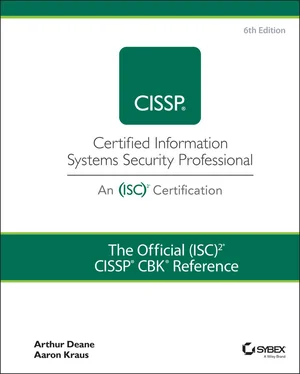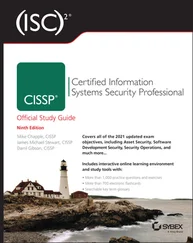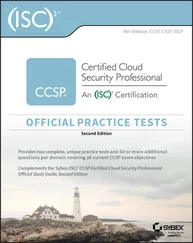Assets are anything that an organization uses to generate value, including ideas, processes, information, and computing hardware. Classifying and categorizing assets allows organizations to prioritize limited security resources to achieve a proper balance of costs and benefits, and this domain introduces important concepts of asset valuation, classification and categorization, and asset handling to apply appropriate protection based on an asset's value. The value of an asset dictates the level of protection it requires, which is often expressed as a security baseline or compliance obligation that the asset owner must meet.
CISSP credential holders will spend a large amount of their time focused on data and information security concerns. The data lifecycle is introduced in this domain to provide distinct phases for determining data security requirements. Protection begins by defining roles and processes for handling data, and once the data is created, these processes must be followed. This includes managing data throughout creation, use, archival, and eventual destruction when no longer needed, and it focuses on data in three main states: in use, in transit, and at rest.
Handling sensitive data for many organizations will involve legal or regulatory obligations to protect specific data types, such as personally identifiable information (PII) or transactional data related to payment cards. Payment card data is regulated by the Payment Card Industry (PCI) Council, and PII often requires protections to comply with regional or local laws like the European Union General Data Protection Regulation (EU GDPR). Both compliance frameworks dictate specific protection obligations an organization must meet when collecting, handling, and using the regulated data.
Security Architecture and Engineering
The Security Architecture and Engineering domain covers topics relevant to implementing and managing security controls across a variety of systems. Secure design principles are introduced that are used to build a security program, such as secure defaults, zero trust, and privacy by design. Common security models are also covered in this domain, which provide an abstract way of viewing a system or environment and allow for identification of security requirements related to the CIANA+PS principles. Specific system types are discussed in detail to highlight the application of security controls in a variety of architectures, including client- and server-based systems, industrial control systems (ICSs), Internet of Things (IoT), and emerging system types like microservices and containerized applications.
This domain presents the foundational details of cryptography and introduces topics covering basic definitions of encryption, hashing, and various cryptographic methods, as well as attacks against cryptography known as cryptanalysis. Applications of cryptography are integrated throughout all domains where relevant, such as the use of encryption in secure network protocols, which is covered in Chapter 4. Physical architecture security — including fire suppression and detection, secure facility design, and environmental control — is also introduced in this domain.
Communication and Network Security
One major value of modern information systems lies in their ability to share and exchange data, so fundamentals of networking are presented in the Communication and Network Security domain along with details of implementing adequate security protections for these communications. This domain introduces common models used for network services, including the Open Systems Interconnection (OSI) and Transmission Control Protocol/Internet Protocol (TCP/IP) models. These layered abstractions provide a method for identifying specific security risks and control capabilities to safeguard data, and the domain presents fundamentals, risks, and countermeasures available at each level of the OSI and TCP/IP models.
Properly securing networks and communications requires strategic planning to ensure proper architectural choices are made and implemented. Concepts of secure network design — such as planning and segmentation, availability of hardware, and network access control (NAC) — are introduced in this domain. Common network types and their specific security risks are introduced as well, including software-defined networks (SDNs), voice networks, and remote access and collaboration technologies.
Identity and Access Management
Controlling access to assets is one of the fundamental goals of security and offers the ability to safeguard all five CIANA+PS security concepts. Properly identifying users and authenticating the access they request can preserve confidentiality and authenticity of information, while properly implemented controls reduce the risk of lost or corrupted data, thereby preserving availability and integrity. Logging the actions taken by identified users or accounts supports nonrepudiation by verifiably demonstrating which user or process performed took a particular action.
The Identity and Access Management (IAM) domain introduces important concepts related to identifying subjects and controlling their access to objects. Subjects can be users, processes, or other systems, and objects are typically systems or data that a subject is trying to access. IAM requirements are presented through four fundamental aspects, including identification, authentication, authorization, and accountability (IAAA). The domain also presents important concepts for managing identities and access, including federation and the use of third-party identity service providers.
Security Assessment and Testing
It is necessary to evaluate the effectiveness of security controls to determine if they are providing sufficient risk mitigation. Assessment, testing, and auditing are methods presented in this domain that allow a security practitioner to identify deficiencies in the security program and prioritize remedial activities.
Assessment and testing can be performed as an internal or external function; while both are appropriate for monitoring security program status, there are situations that require external evaluations. For instance, third-party audits are common in situations where an assessment must be conducted that is free of any conflict of interest. External audit reports, such as the Service Organization Control or SOC 2, can be useful for organizations to communicate details of their security practices to external parties like vendors or business partners. In this case, the auditor's independence from the audited organization provides additional assurance to consumers of the report.
Ethical penetration testing and related technical testing topics are presented in this domain, including test coverage and breach attack simulations. These types of tests can be conducted against a range of targets from individual information systems to entire organizations and are a valuable tool to identify deficiencies in security controls. The disclosure and handling of any findings from such testing is also discussed, including legal and ethical implications of information that might be discovered.
An ongoing assessment and testing program is also useful for establishing continuous monitoring and supporting compliance needs. Properly designed and implemented strategies for testing security controls, vulnerabilities, and attack simulations measure the effectiveness of the organization's existing control program. Any identified deficiencies must be addressed to ensure adequate risk management.
Security Operations (SecOps) is a companion to the other domains in the CBK, and this chapter deals with implementing, operating, and maintaining infrastructure needed to enable the organization's security program. Security practitioners must first perform a risk assessment and then design and operate security controls spanning technology, people, and process to mitigate those risks. SecOps is a key integration point between security teams and other parts of the organization such as Human Resources (HR) for key tasks like designing job rotations or segregation of duties, or a network engineering team that is responsible for implementing and maintaining firewalls and intrusion detection systems (IDSs).
Читать дальше












